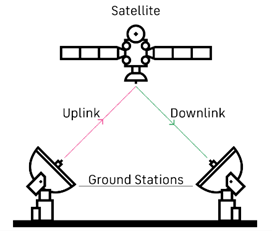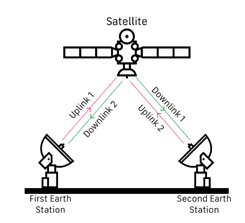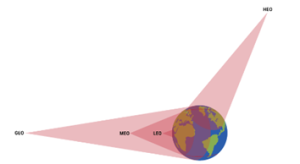By now, most of us are aware that satellite technology represents the future of global communication and information transfer. By using a combination of orbiting satellites and ground stations, this innovative technology seamlessly connects people and places across the world, even in the most remote and inaccessible locations. A diverse range of sectors are being transformed by advances in satellite technology, not just in telecommunications, but also in mining, landfill, infrastructure, and security, to name just a few.
But as with all advances in technology, there’s a whole new language that needs to be learned. Understanding the difference between your GEOs, LEOs and HEOs and the pros and cons of each type of satellite communication is not yet second nature to us all. So, here’s a bit of a run down on all things satellite.
Communications satellites:
Communications satellites follow a standard three-stage process for transmitting and relaying data, as follows:
- Uplink: A transmission is sent out from a ground station to a specific satellite
- Transponder: Once the transmission reaches the orbiting satellite, onboard amplifiers enhance the signal’s strength and modifies its frequency. The boosted signal is then relayed back down to designated earth stations
- Downlink: Transmitters then send one or multiple signals across the Earth to other ground stations, completing the communication loop.

Image from https://www.inmarsat.com/en/insights/corporate/2023/a-straightforward-introduction-to-satellite-communications.html
Two-way satellites:
A more advanced system of satellite technology is a two-way satellite. This process of communication offers point-to-point connectivity, allowing information to go back and forth between ground stations using the same satellites. This opens up possibilities for internet access in the most remote and challenging locations.

Image from https://www.inmarsat.com/en/insights/corporate/2023/a-straightforward-introduction-to-satellite-communications.html
Different types of satellites:
There are four types of satellites, each orbiting the Earth at different speeds and altitudes.
Geostationary Earth Orbit (GEO) satellites are the furthest away from our planet and match the Earth’s rotational speed. They are highly efficient due to their expansive coverage area and ability to focus capacity on specific areas when required. These satellites are perfect for mobile satellite communication services, where uninterrupted and reliable connectivity is essential, such as in maritime and aviation safety services.
Medium Earth Orbit (MEO) satellites, orbit between 2000km and 35,700km above the Earth, and play an important role in GPS and other navigation applications. MEO satellites provide low-latency, high-bandwidth connectivity. This connectivity offers internet connection to remote areas where laying fibre-optic cables is not possible. Another advantage of MEOs is their ability to accomplish such tasks with fewer satellites, while also reducing latency. They are useful to service providers, government agencies, and commercial enterprises.

Image from https://www.inmarsat.com/en/insights/corporate/2023/a-straightforward-introduction-to-satellite-communications.html
Low Earth Orbit (LEO) satellites are the smallest in both size and distance from the Earth, orbiting between 160km and 2000km. Their smaller field of vision and low latency, allows them to efficiently transmit vast amounts of data at greater speeds with a stronger signal strength. This makes them well-suited for applications such as industrial IoT, maritime and tourism, government and tactical networks, emergency response and aid, telecommunications, and mobile 5G broadband.
However, there are several downsides. LEO satellites. Not only do they require a larger constellation of satellites for optimal function, but they also have a shorter lifespan of between five and seven years, versus others like GEO, which can last 15+ years. As it takes two to three years to deploy LEO satellites, they only have an active lifespan of two to three years before needing replacement. This high turnover rate raises concerns about space debris and sustainability.
Highly Elliptical Orbit (HEO) satellites follow an elliptic orbital path, resulting in a wide range of altitudes, varying from 1000 km to 42,000 km. They exhibit varying speeds, moving faster when in closer proximity to Earth, due to gravitational pull. To achieve seamless connectivity, two HEO satellites are required. In this way, longer coverage is ensured when satellites are at the tip of the North Pole, offering a wider scope of service.
Satellite technology is making the world more connected and accessible. It’s a key player in the future of global communication and information transfer.






